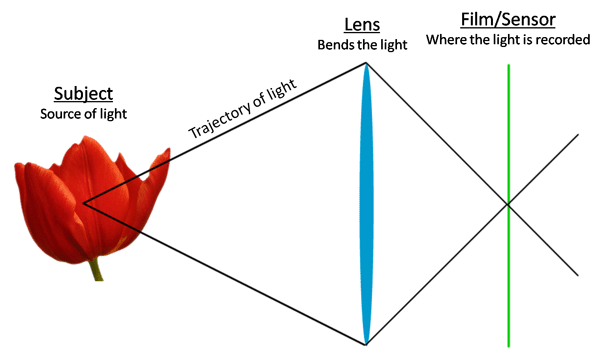Thanks. I was thinking of using some of this information in a class and very much appreciate your reply. Here's the graphic:

It does seem to be leaving off the lens part, the focusing, thus:

But I *think* this illustrates that light reflected at different angles - from the same subject point - are bent to hit the same point on the focal plane.
But this happens for every point of the subject and across the area of the sensor/retina:

So I think the article graphic is saying a larger pupil/aperture results in a larger image on the retina, more data points or information.
As you say, it is obvious that a larger opening allows more light, but the article graphic is about another variable, retina area.
I'm not at all sure about this, I looked twice at the graphic also. Appreciate your response or anyone else who cares to weigh in.
thanks again.
In regard to the second image, your surmise is correct. It goes hand-in-hand with my previous verbal description. Just imagine the lens being of varying diameter, but the same focal length. The rays emanating from a single point on the subject (at left) which make it through the lens will then converge on the single corresponding point on the image plane.
It's just a matter of how wide a cone of rays--how many rays--radiating from a given point on the image will make it through the aperture; this is determined of course by the area of said aperture.
The third image shows a single ray from each of two points on the subject (namely, the one in each case which passes through the center of the lens) and finds its way, along with others not shown, to the corresponding point on the image plane. Because the particular rays shown pass through the center of the lens, their path is not disturbed by it; a pinhole would work the same.
Now as to your conjecture that "a larger pupil/aperture results in a larger image on the retina," it doesn't do that. If the lens were just a blank hole of varying size (which the original illustraton essentially shows), you'd get more light from a larger hole but it would just be a blob on the retina. Reduce the size of the hole and you get less light but also the beginnings of an image, until you get to a very small aperture where you have a dim image being produced by a pinhole.
With a lens there, however, you get a focussed image regardless of the size of the aperture; a larger aperture doesn't change the size or magnification of the image, just its brightness.
Of course, aperture size does affect the range of distances that are essentially in focus (called "depth of field), but that's a different can o'"worms.


